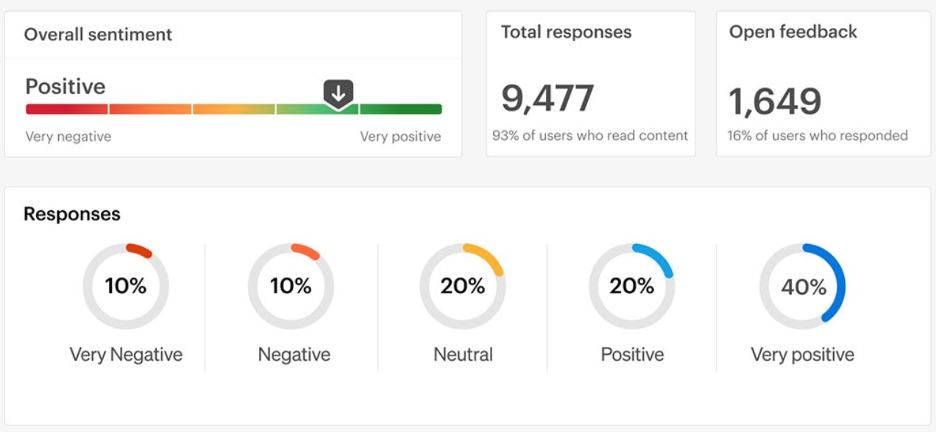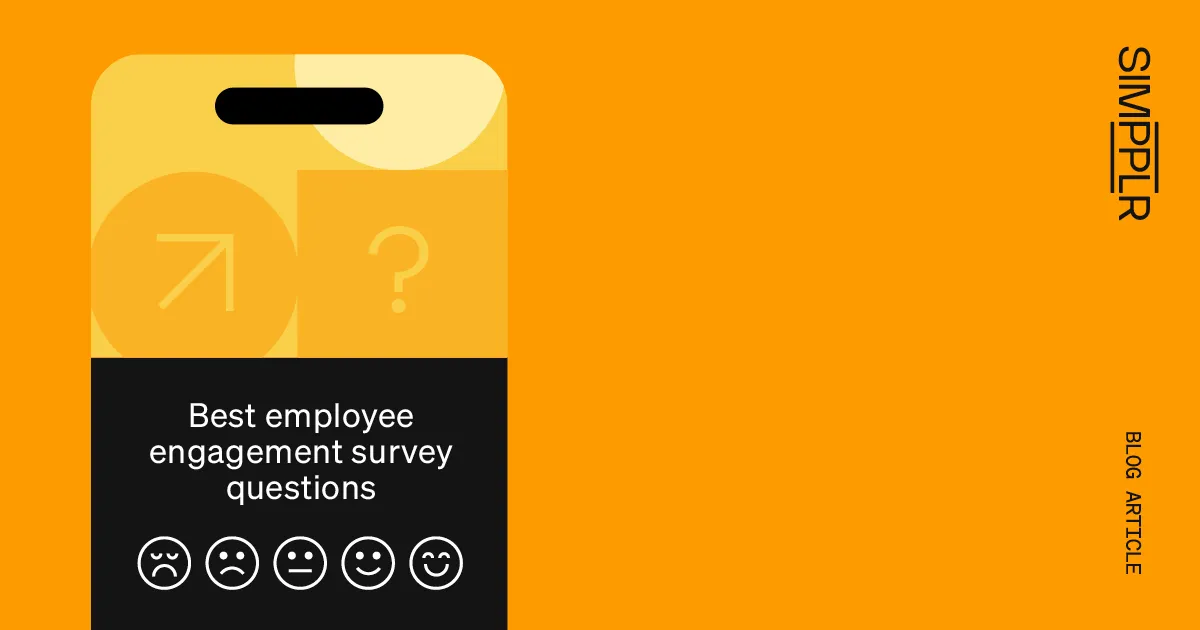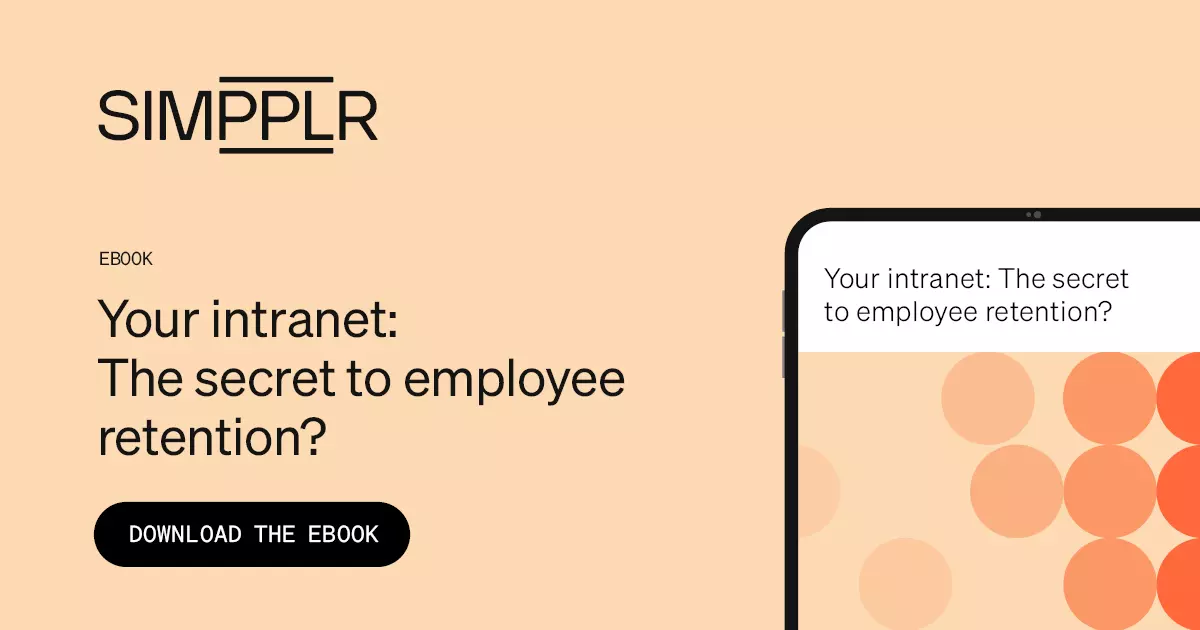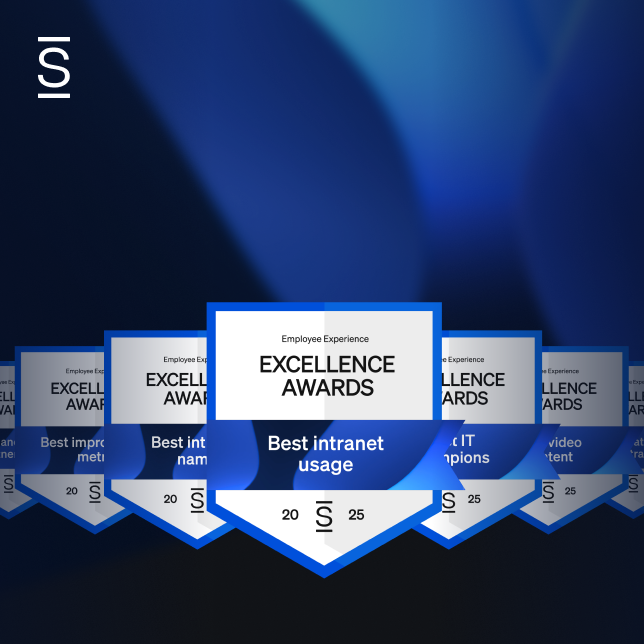When recession looms, it’s important to make every effort to retain top talent. A good way to keep your star performers happy is to ensure that employee experience in your organization is the very best it can be.
This means having all the building blocks contributing to a stellar employee experience in place. And an integral part of this experience is employee sentiment. We’ll be taking an in-depth look at this below, discussing measurement methods, analytics, actions to be taken, and why this all matters.
What is employee sentiment
Sentiment is the way someone feels about something, their point of view or their opinion. Attitudes, beliefs, and mood also contribute to the concept of sentiment, along with any thoughts or ideas based on a feeling. Employee sentiment can therefore be defined basically as the way a worker feels about their job.

Simpplr’s intranet employee sentiment dashboard
Employee sentiment is not the same as employee experience or employee engagement but is an important factor in both.
Methods to measure employee sentiment
To connect and understand the essence of what matters in the workplace, it’s vital to measure the levels of employee sentiment in your organization. Here are a few ways to do this:
Using surveys to evaluate sentiment
Surveys are one of the best ways to evaluate employee sentiment, but gone are the days of the lengthy, laborious annual survey. Shorter, more regular, focused surveys are the best way to gather sentiment data and deliver rapid feedback.
Relevant, clear, open-ended questions are best, and while multiple-choice options can be included, it’s good to let people express opinions in their own words. Anonymous surveys are recommended so workers feel free to tell the truth without retribution.
Having an area on your intranet where short surveys can be done anonymously every week or answers collated daily to a simple yes/no question is one way of starting a regular measurement of sentiment in your organization.
Interviews offer unique insight

Interviews can be done face-to-face or online depending on where employees are located. Lack of anonymity can be a drawback, so it’s important for the interviewer to have neutral status, or there’s a good chance people will feel inhibited.
Like surveys, it’s wise to keep interviews short, regular, and specific to maintain a state of connection and caring and cater to differing moods. As employees become accustomed to these interactions and develop a foundation of trust, unique insight will emerge. This valuable feedback will provide a clear picture of sentiment and how it changes based on internal and external influences.
Focus groups share specific intel
A focus group goes beyond getting a few people around a table and throwing some ideas around. Again, similar to interviews, it’s best if the group leader is neutral so people feel free to express themselves honestly. Take time to formulate focused questions because these will give you specific details rather than a general opinion.
So, ask a question eliciting specifics like, “If there were one thing that you could change to make you happier at work today, what would it be?” Don’t ask, “How do you feel about working in this company?” You will receive more actionable feedback with the former.
The focus group leader must encourage each group member to participate freely. Listening well is very important, and differing opinions and disagreements are to be expected.
Social media listening for brand health
Comments from text-based sites like Twitter and visual sites like Instagram can all be analyzed to discover what consumers say about your offerings. This reveals the kind of reputation your company has internally and externally.
Social media sentiment analysis can also reveal influencers of value to your organization’s digital marketing strategy.
Examples of organizations measuring employee sentiment
- Rabobank, Financial Services Provider, UK
Rabobank used continuous social listening and analyzed text to gauge employee sentiment during the COVID-19 pandemic. Feedback quickly provided ideas and solutions for how best to support and understand workers during a difficult time.
- Nottingham Health Trust, NHS Foundation Trust, UK
This trust has started looking at options around sentiment analysis to understand low employee engagement and survey fatigue
- Alphabet Company, USA
Over several years, the tech company implemented Project Oxygen to find out what goes into the making of a great Google manager and whether managers were actually necessary at all. Metrics regarding management were analyzed along with job satisfaction and productivity data.
How to analyze the results of employee sentiment measurements

Analyzing employee sentiment measurements reveals perceptions around the brand and feelings on how management is running the company. And while it is difficult to pinpoint unhappy individuals, overall trends will be easily seen. The analysis will also give an idea of what people say about the company.
Many leading companies use AI technology to gather and analyze employee data. AI technology is developing in leaps and bounds. It offers a broader view of sentiment, identifying actionable issues and appropriate actions that need to be taken.
Employee sentiment data is analyzed by software, so the text of each discussion or conversation can be evaluated for emotion, intent, and tone. By analyzing these elements, the software, or tools, reveal the deeper contexts of these exchanges, providing more specific feedback to enable better employee support.
There are several tools to use when analyzing employee sentiment data gathered through surveys, interviews, focus groups, social listening, and other methods. And HR departments must choose according to their organizations’ missions, goals, and sectors in which they operate.
Apart from exposing general employee sentiment across text and visual channels, these tools also uncover trends, identify hot topics of conversation, and discover new influencers. Some process languages and some scan open-ended comments to understand the meaning of what has been left unsaid.
The analysis will also indicate satisfaction levels in the workplace, identify themes, and reveal insights that otherwise could have gone unnoticed. Response rates will give a healthy indication of employee investment in the process.
Employee sentiment analysis tools are an excellent way to save time collating, reporting, and acting on feedback.
Measuring and acting on employee sentiment
What could be worse than spending time completing a long survey only to find nothing happens as a result of that effort? Likewise, employees won’t have sympathy for a process probing their feelings, emotions, and moods if no positive results come from baring their souls.
Don’t sit on that data once you know what your workforce thinks and feels. Nobody wants survey results months after the event, so it’s important to jump into action and let employees know their contributions are important.
- Be prepared for some surprising insights. Remember that employees can be aware of things management has no clue about.
- Keep surveying so you have a constant supply of real-time feedback while you take action on issues arising from the analysis.
- Be aware of changing sentiments during the process and ask why—is it due to management, business process, insecurity, or something entirely different?
- Share data freely and give leaders direct access to data, unfiltered by HR, so actionable issues are not delayed.
- Support anonymity so employees feel secure while supplying honest feedback.
- Identify and focus on what needs immediate fixing and implement changes.
- Set goals so employees know what the workforce is aiming for as a whole and that their contributions are worthwhile.
- Track progress to ensure you have the best tools in place to measure employee sentiment and know how to take action where things need adjusting.
At some time or other, we’ve all received that text or email from a work colleague or family member and thought, “Are they serious? Or is this a joke?” It’s hard to read between the lines and capture the sentiment of the text word or even a video message, and this is why the measurement of employee sentiment matters.
Employee sentiment affects employee engagement and the employee experience as a whole, so it’s important to choose the correct methods and software tools for your company and sector. Once the data collected from these measurements is analyzed, you’ll have the insights necessary to take action and get to the heart of what your employees feel about their jobs and what they mean when they talk about them.
Reach out for a demo, and we’ll show you how sentiment analysis can look behind the scenes and how to get started with it today.


















